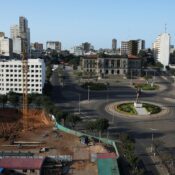
As it intensifies in the Caribbean, Hurricane Beryl is deemed “very dangerous”
Hurricane Beryl hit the Eastern Caribbean on Monday, tearing off roofs from buildings and bringing down power lines. Scientists believe that the hurricane grew exceptionally swiftly due to climate change.
Beryl made landfall in the southeast Caribbean at a Category 4 intensity on the Saffir-Simpson five-point scale. As the potentially fatal winds increased, Beryl spiraled toward the Windward Islands of the Caribbean, posing a possibility of catastrophic flooding.
“This is a potentially fatal condition that is exceedingly risky. Due to an anticipated sharp rise in wind force, the U.S. National Hurricane Center advised people of Grenada, the Grenadine Islands, and Carriacou Island to seek shelter in place on Monday. “Take action now to protect your life!” the center wrote in a post.
As the storm approached, people on many of the islands that make up the Eastern Caribbean boarded up windows, stocked up on food, and fueled their cars with gasoline.
From Beryl’s well-defined eye, hurricane-force winds could reach up to 40 miles (64 km) and severe tropical storm force winds could reach up to 125 miles (201 km) further out. This information was reported by the hurricane center located in Miami.
With Beryl’s quick ascent, the Atlantic hurricane season this year got off to an exceptionally strong and early start, with the earliest Category 4 storm ever recorded.
According to Reuters’ survey of scientists, the strong hurricane portends an exceptionally busy hurricane season, which is made possible by the Atlantic Ocean’s record-high temperatures.
According to Christopher Rozoff, an atmospheric scientist at the National Center for Atmospheric Research in Boulder, Colorado, in the United States, “climate change is loading the dice for more intense hurricanes to form.”
Meteorologist Andra Garner of New Jersey observed that Beryl went from a Category 1 to a Category 4 storm in less than ten hours.
Leaders in the area, including Ralph Gonsalves, the prime minister of St. Vincent and the Grenadines, tried to get people ready for the worst. He declared that a natural calamity that would last for days was what he was expecting.
“In a speech to the nation, we have to wait this monster out.”
Conditions surrounding the major harbor in Kingstown, the capital, deteriorated on Monday morning. Building damage was recorded as a result of the winds getting stronger. Video from the city showed wind-beaten palm plants along the shoreline and waves smashing over a seawall.
By Monday afternoon, Beryl’s greatest sustained wind speed had reached 150 miles per hour (241 km/h). The weather phenomena was situated approximately 65 miles (105 km) northwest of Grenada.
According to the U.S. hurricane center, Beryl is traveling 20 mph (32 kph) northwest and is expected to pass over several of the most populous islands in the central Caribbean by Wednesday as it makes its way toward the Gulf of Mexico.
As the hurricane passes over the Windward Islands, the center predicts that it will cause “potentially catastrophic wind damage,” with Grenada and St. Vincent and the Grenadines being most vulnerable.
There have been reports of houses having their roofs torn off in Prospect, St. Vincent, and power outages in other areas of the island.
On Grenada, a Reuters correspondent said that the entire island was without power.
The Fingerprints of Climate Change
As a result of the North Atlantic’s record high temperatures brought about by global warming, more surface water is evaporating, adding fuel to the fire for hurricanes with stronger winds and more intensity.
According to meteorologist Garner, scientists have already anticipated that as climate change occurs, the likelihood of storms like Beryl will increase. According to her research, the likelihood of storms becoming major hurricanes in less than a day has increased by more than twice due to rising water temperatures over the past fifty years.
According to the hurricane center, Jamaica was placed under a hurricane watch, and St. Vincent and the Grenadines, Grenada, and other areas were under hurricane warnings.
Shelters were opened and schools closed on Monday in neighboring Tobago.
“The island’s eastern side took the worst of the damage, and the waves are still hazardous. As a result of receiving enough notice, fishermen were able to take their boats out of the sea, according to All-Tobago Fisherfolk Association President Curtis Douglas.
A local hotel and tourism agency reports that there has been very little damage to hotel buildings on the island thus far.
Monday’s rains from the hurricane are predicted to range from 3 to 6 inches (8 to 15 cm) across Barbados and the Windward Islands, with some regions receiving as much as 10 inches (25 cm), particularly in the Grenadines, Tobago, and Grenada.
The National Oceanic and Atmospheric Administration of the United States forecasted above-average storm activity in the Atlantic this year in May, along with abnormally high sea temperatures.
While on vacation in Barbados, Canadian travel blogger “Khanadians” Nauman Khan posted a video from his hotel early on Monday morning, describing “really massive waves.”
He claimed to have spoken with some locals. “Just knowing that people were taking it in their stride, this is a part of life in the West Indies … it gave us some reassurance.”
All Categories
Recent Posts
Tags
+13162306000
zoneyetu@yahoo.com


